The Cost of a Pretty Penny
March 2010
By Kenya Brown Fusciello, MAC Lab Conservator
In the early 17th and 18th centuries, British American colonies did not often use coins because mercantilism was based on traded products from foreign lands. Most of England’s loot was a result of robbing enemy ships of their gold and silver. Any coins that infrequently came into the Colonists' possession originated from Spain, Latin America, the Netherlands and France. 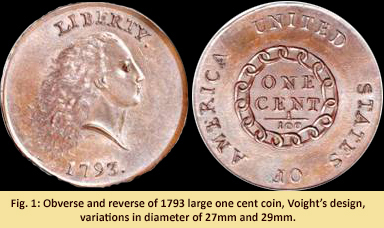 It wasn't until the late 18th century that Colonial America introduced its own monetary system influenced by exchanges between itself and other countries (Lasser, 1997).
It wasn't until the late 18th century that Colonial America introduced its own monetary system influenced by exchanges between itself and other countries (Lasser, 1997).
The first installation of what we know as the penny was done by engraver, Henry Voight, in 1793. Before the concept of the penny, the “ONE CENT” coin would endure several versions between the late 1800s and the early 1900s. Voight's design of the Liberty figure with wild and winded hair on the obverse side and the "ONE CENT" text encircled by a chain on the reverse side became the first draft of many revisions to follow in its history (Fig.1).
Only 36,103 coins of this version were minted because Voight suffered widespread criticism for the coin's "unattractiveness and allusion to slavery". The very same year, Mint Director, David Rittenhouse, ordered engraver Adam Eckfeldt to implement two different designs. The barrage of negative opinions coming from the public and Rittenhouse on Eckfeldt's designs forced the production of other versions of the coin to ensue. Other designs made by Eckfeldt and various engravers following his efforts continued for a period of 64 years from 1793 to 1857.
Because One Cent coins were discontinued two centuries ago, their appearances are extremely rare. Oxon Hill, Maryland's Addison Plantation, a site determined by archaeologists to have existed between the 18th century and early 20th century, held 19 One Cent coins. Five of those coins contain visible dates shown at the bottom of the Liberty head figure.
Addison was a Colonial plantation where the elite of Maryland lived including the Addison and Berry families. The wealth of the Addisons originated from tobacco cultivation. The Berrys raised livestock and grew wheat. In the same area where the coins were found were 14 shovel test pits that included creamware, pearlware, whiteware, Jackfield and yelloware sherds; fragments of olive bottle glass, and nails (Milner & Associates, 1986).
Curator of the Addison collection at the Maryland Archaeological Conservation Laboratory, Rebecca Morehouse, finds the amount of coins recovered to be interesting. The rich economy of both families could explain their presence. Furthermore, the Berrys leased much of their property receiving cash payments for their rentals.
Physical assessments of the coins dictate uneven edges around the diameter and corrosion underneath layers of hardened soil (Fig. 2). Their weights and diameters varied which is typical considering the individual rates of degradation. The coins were treated using ethanol to soften and loosen the soil. After removal of the soil, corrosion products became more apparent and the dates of their mintages were revealed. The coins were treated in a solution used to stabilize corrosion and then a protective coating was applied to counteract environmental humidity and salt (Fig. 3, Fig. 3.1).
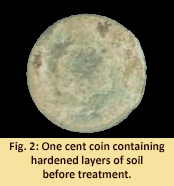
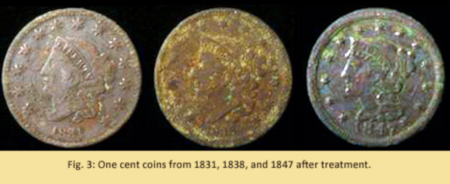

The design of what is commonly known as the 'penny' today was designed by Victor D. Brenner in 1909. Unlike its predecessors, these images show former President, Abraham Lincoln on the obverse side. The installation of the Lincoln Memorial on the reverse was not created until 1959 (Fig. 4). Although the obverse side of the modern day penny containing the Lincoln figure is still in circulation today, the reverse side in 2010 has been redesigned with a Union Shield containing a ribbon with the engraved text "One Cent" (Fig. 5). What makes Addison's One Cent coins so valuable are their engraved dates, giving them a historical stamp of their presence on the property. These dates establish an archaeological record validating the time period they existed in. The penny in comparison to other coins has the least amount of face value, however, its 200 year history of revisions is priceless.
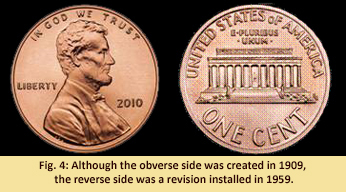
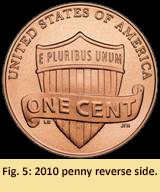
| References |
|
| Lasser, Joseph R., et.al. |
| 1997 |
The Coins of Colonial America, World Trade Coins of the Seventeenth and Eighteenth Centuries. Williamsburg, Virginia: The Colonial Williamsburg Foundation. |
|
| Milner, John and Associates |
| 1986 |
Intensive Archaeology Survey of the Addison Plantation site and Intensive testing of the Addison Manor Foundations. Beltway Parcel Port America Development, Oxon Hill, Prince George's County. |
|
| Morehouse, Rebecca |
| 2010 |
Personal Communication. Collections Curator, MAC lab |
|
| Yeoman, R. S. |
| 2009 |
A Guide Book of United States Coins. New York, New York. Golden Books Publishing Company, Inc. |
|
|